Network Model and Topologies for Blue Sky Optical
VerifiedAdded on 2023/06/04
|7
|1634
|259
AI Summary
This article discusses the best network model and topology for Blue Sky Optical, comparing and contrasting star, ring, and bus topologies. It also explores the benefits of selecting an internet-based architecture, using a wireless network, and choosing in-house development versus a packaged solution.
Contribute Materials
Your contribution can guide someone’s learning journey. Share your
documents today.
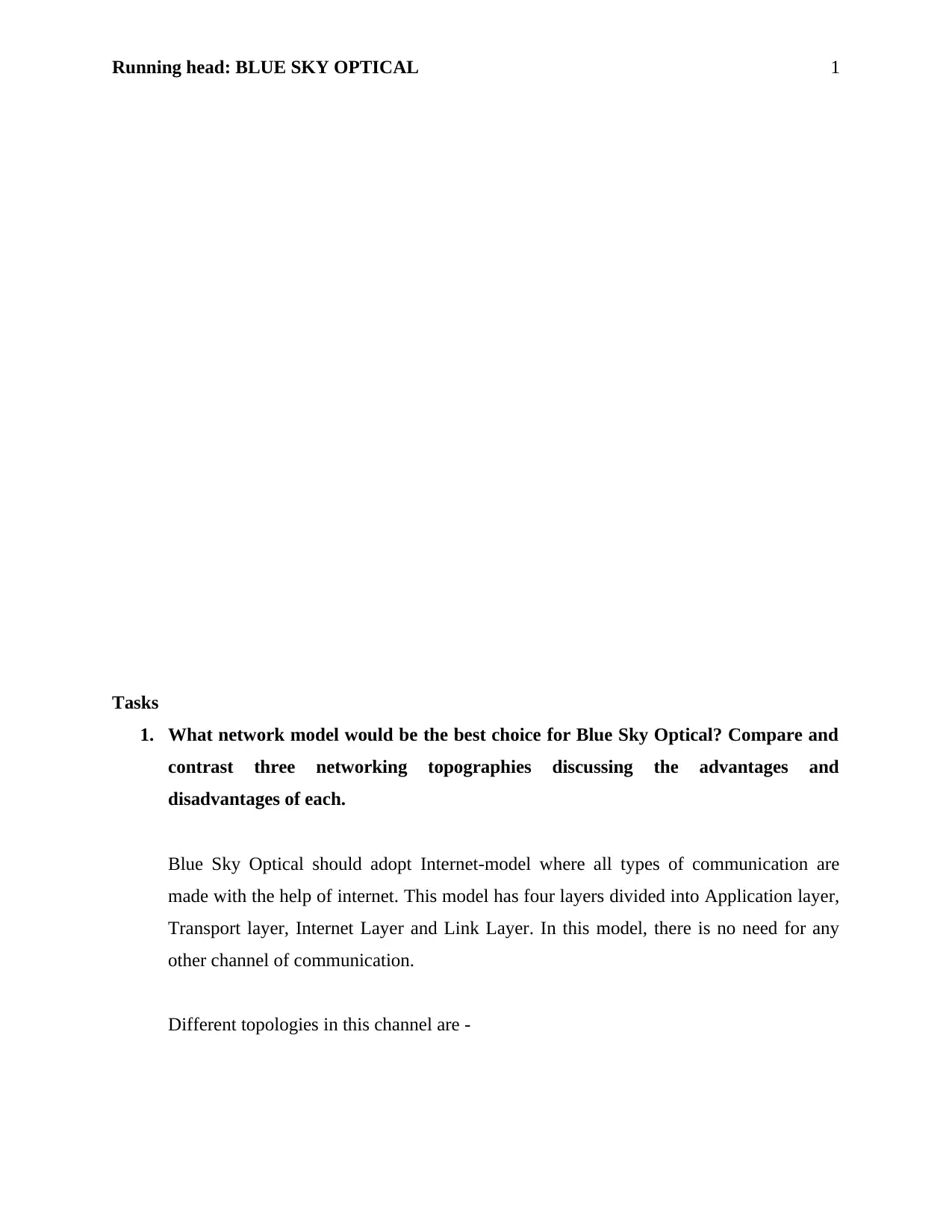
Running head: BLUE SKY OPTICAL 1
Tasks
1. What network model would be the best choice for Blue Sky Optical? Compare and
contrast three networking topographies discussing the advantages and
disadvantages of each.
Blue Sky Optical should adopt Internet-model where all types of communication are
made with the help of internet. This model has four layers divided into Application layer,
Transport layer, Internet Layer and Link Layer. In this model, there is no need for any
other channel of communication.
Different topologies in this channel are -
Tasks
1. What network model would be the best choice for Blue Sky Optical? Compare and
contrast three networking topographies discussing the advantages and
disadvantages of each.
Blue Sky Optical should adopt Internet-model where all types of communication are
made with the help of internet. This model has four layers divided into Application layer,
Transport layer, Internet Layer and Link Layer. In this model, there is no need for any
other channel of communication.
Different topologies in this channel are -
Secure Best Marks with AI Grader
Need help grading? Try our AI Grader for instant feedback on your assignments.
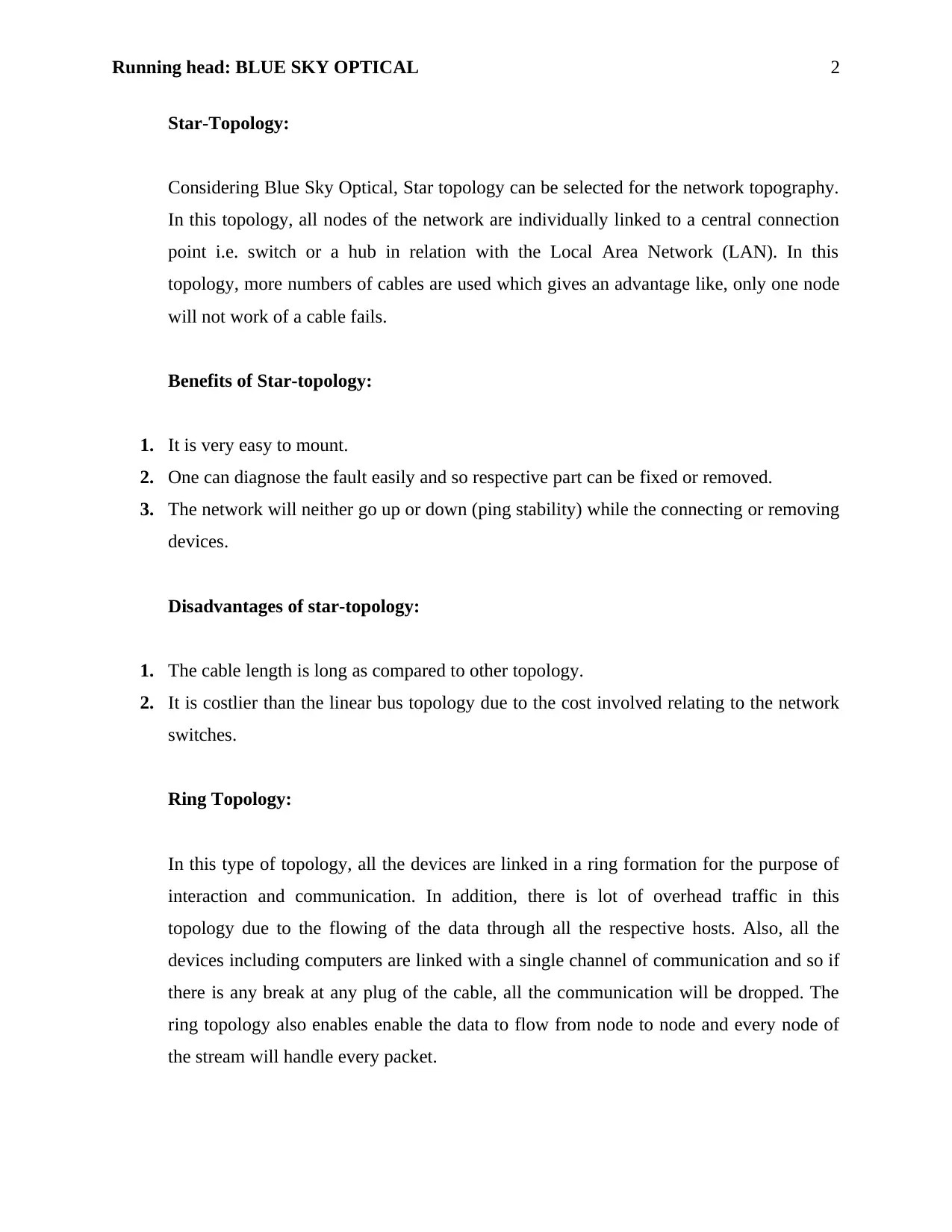
Running head: BLUE SKY OPTICAL 2
Star-Topology:
Considering Blue Sky Optical, Star topology can be selected for the network topography.
In this topology, all nodes of the network are individually linked to a central connection
point i.e. switch or a hub in relation with the Local Area Network (LAN). In this
topology, more numbers of cables are used which gives an advantage like, only one node
will not work of a cable fails.
Benefits of Star-topology:
1. It is very easy to mount.
2. One can diagnose the fault easily and so respective part can be fixed or removed.
3. The network will neither go up or down (ping stability) while the connecting or removing
devices.
Disadvantages of star-topology:
1. The cable length is long as compared to other topology.
2. It is costlier than the linear bus topology due to the cost involved relating to the network
switches.
Ring Topology:
In this type of topology, all the devices are linked in a ring formation for the purpose of
interaction and communication. In addition, there is lot of overhead traffic in this
topology due to the flowing of the data through all the respective hosts. Also, all the
devices including computers are linked with a single channel of communication and so if
there is any break at any plug of the cable, all the communication will be dropped. The
ring topology also enables enable the data to flow from node to node and every node of
the stream will handle every packet.
Star-Topology:
Considering Blue Sky Optical, Star topology can be selected for the network topography.
In this topology, all nodes of the network are individually linked to a central connection
point i.e. switch or a hub in relation with the Local Area Network (LAN). In this
topology, more numbers of cables are used which gives an advantage like, only one node
will not work of a cable fails.
Benefits of Star-topology:
1. It is very easy to mount.
2. One can diagnose the fault easily and so respective part can be fixed or removed.
3. The network will neither go up or down (ping stability) while the connecting or removing
devices.
Disadvantages of star-topology:
1. The cable length is long as compared to other topology.
2. It is costlier than the linear bus topology due to the cost involved relating to the network
switches.
Ring Topology:
In this type of topology, all the devices are linked in a ring formation for the purpose of
interaction and communication. In addition, there is lot of overhead traffic in this
topology due to the flowing of the data through all the respective hosts. Also, all the
devices including computers are linked with a single channel of communication and so if
there is any break at any plug of the cable, all the communication will be dropped. The
ring topology also enables enable the data to flow from node to node and every node of
the stream will handle every packet.
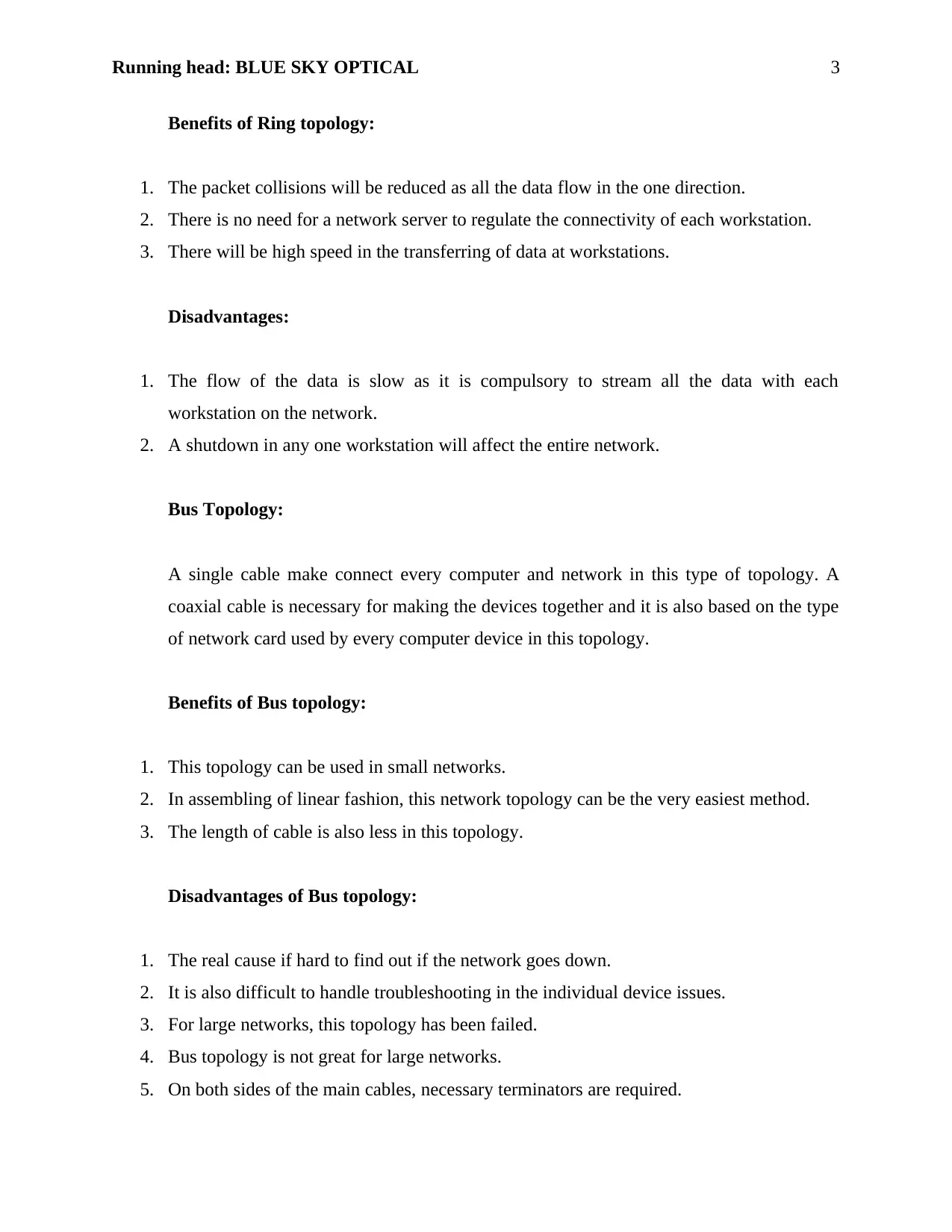
Running head: BLUE SKY OPTICAL 3
Benefits of Ring topology:
1. The packet collisions will be reduced as all the data flow in the one direction.
2. There is no need for a network server to regulate the connectivity of each workstation.
3. There will be high speed in the transferring of data at workstations.
Disadvantages:
1. The flow of the data is slow as it is compulsory to stream all the data with each
workstation on the network.
2. A shutdown in any one workstation will affect the entire network.
Bus Topology:
A single cable make connect every computer and network in this type of topology. A
coaxial cable is necessary for making the devices together and it is also based on the type
of network card used by every computer device in this topology.
Benefits of Bus topology:
1. This topology can be used in small networks.
2. In assembling of linear fashion, this network topology can be the very easiest method.
3. The length of cable is also less in this topology.
Disadvantages of Bus topology:
1. The real cause if hard to find out if the network goes down.
2. It is also difficult to handle troubleshooting in the individual device issues.
3. For large networks, this topology has been failed.
4. Bus topology is not great for large networks.
5. On both sides of the main cables, necessary terminators are required.
Benefits of Ring topology:
1. The packet collisions will be reduced as all the data flow in the one direction.
2. There is no need for a network server to regulate the connectivity of each workstation.
3. There will be high speed in the transferring of data at workstations.
Disadvantages:
1. The flow of the data is slow as it is compulsory to stream all the data with each
workstation on the network.
2. A shutdown in any one workstation will affect the entire network.
Bus Topology:
A single cable make connect every computer and network in this type of topology. A
coaxial cable is necessary for making the devices together and it is also based on the type
of network card used by every computer device in this topology.
Benefits of Bus topology:
1. This topology can be used in small networks.
2. In assembling of linear fashion, this network topology can be the very easiest method.
3. The length of cable is also less in this topology.
Disadvantages of Bus topology:
1. The real cause if hard to find out if the network goes down.
2. It is also difficult to handle troubleshooting in the individual device issues.
3. For large networks, this topology has been failed.
4. Bus topology is not great for large networks.
5. On both sides of the main cables, necessary terminators are required.

Running head: BLUE SKY OPTICAL 4
Considering the environment of Blue-sky Optical, the best topology will be Star
topology. This topology enables the devices of the computer to link with switches and the
traffic in the network will be condensed. Other system and devices will not be impacted if
there is any problem in one system due to the independency in nature. The cost involved
in this topology is also low and thus it makes the business to increase their performances.
2. What would be the advantages of selecting an Internet-based architecture for the
Blue Sky Optical system?
Here, the solution may be different. For examples, there will be benefit for the students if
they would have the ability to continuously process the transactions with the updating of
files and databases. This will help the organization to get real time data aligned with the
batch processing. Also, implementing this architecture with the web-based application
will create a platform where the various compatibility and connectivity issues can be
avoided with the occurrence of different hardware environments.
The internet services can be used by the company to perceive and analyses the sales, in-
stock inventory from anyplace. Most significant benefit will be the number of systems
that can be aligned with the internet portal as if there any diversification of corporate is
perceived in the future.
3. What would be the benefits of using a wireless network? What would be the
drawbacks?
Advantages of using wireless network –
1. With the help of wireless networks, one can move freely with their devices
connected with the networks.
2. The individuals who are connected with the networks can share their data or
information with the other users easily and effectively without having any hustle
with cable, switched or port.
Considering the environment of Blue-sky Optical, the best topology will be Star
topology. This topology enables the devices of the computer to link with switches and the
traffic in the network will be condensed. Other system and devices will not be impacted if
there is any problem in one system due to the independency in nature. The cost involved
in this topology is also low and thus it makes the business to increase their performances.
2. What would be the advantages of selecting an Internet-based architecture for the
Blue Sky Optical system?
Here, the solution may be different. For examples, there will be benefit for the students if
they would have the ability to continuously process the transactions with the updating of
files and databases. This will help the organization to get real time data aligned with the
batch processing. Also, implementing this architecture with the web-based application
will create a platform where the various compatibility and connectivity issues can be
avoided with the occurrence of different hardware environments.
The internet services can be used by the company to perceive and analyses the sales, in-
stock inventory from anyplace. Most significant benefit will be the number of systems
that can be aligned with the internet portal as if there any diversification of corporate is
perceived in the future.
3. What would be the benefits of using a wireless network? What would be the
drawbacks?
Advantages of using wireless network –
1. With the help of wireless networks, one can move freely with their devices
connected with the networks.
2. The individuals who are connected with the networks can share their data or
information with the other users easily and effectively without having any hustle
with cable, switched or port.
Secure Best Marks with AI Grader
Need help grading? Try our AI Grader for instant feedback on your assignments.
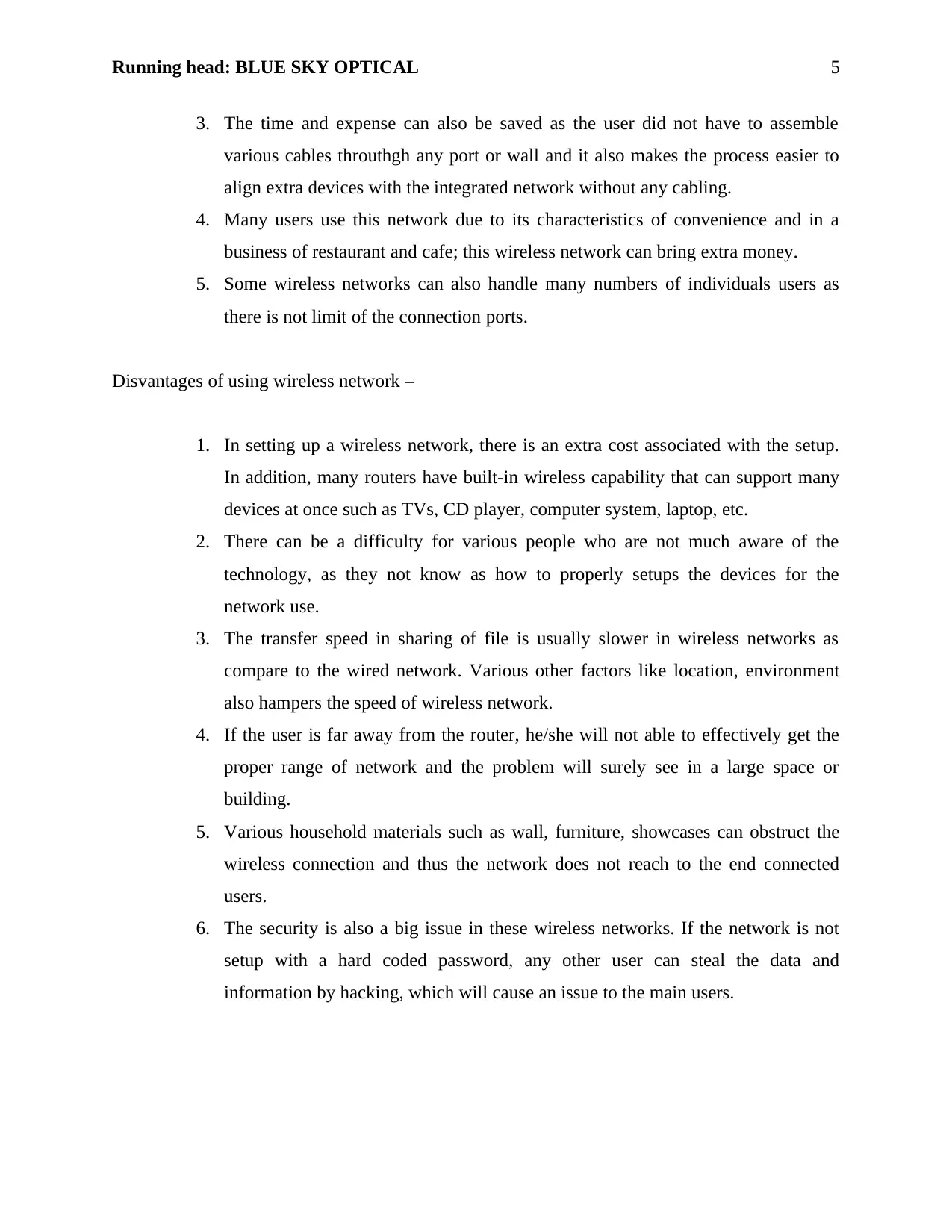
Running head: BLUE SKY OPTICAL 5
3. The time and expense can also be saved as the user did not have to assemble
various cables throuthgh any port or wall and it also makes the process easier to
align extra devices with the integrated network without any cabling.
4. Many users use this network due to its characteristics of convenience and in a
business of restaurant and cafe; this wireless network can bring extra money.
5. Some wireless networks can also handle many numbers of individuals users as
there is not limit of the connection ports.
Disvantages of using wireless network –
1. In setting up a wireless network, there is an extra cost associated with the setup.
In addition, many routers have built-in wireless capability that can support many
devices at once such as TVs, CD player, computer system, laptop, etc.
2. There can be a difficulty for various people who are not much aware of the
technology, as they not know as how to properly setups the devices for the
network use.
3. The transfer speed in sharing of file is usually slower in wireless networks as
compare to the wired network. Various other factors like location, environment
also hampers the speed of wireless network.
4. If the user is far away from the router, he/she will not able to effectively get the
proper range of network and the problem will surely see in a large space or
building.
5. Various household materials such as wall, furniture, showcases can obstruct the
wireless connection and thus the network does not reach to the end connected
users.
6. The security is also a big issue in these wireless networks. If the network is not
setup with a hard coded password, any other user can steal the data and
information by hacking, which will cause an issue to the main users.
3. The time and expense can also be saved as the user did not have to assemble
various cables throuthgh any port or wall and it also makes the process easier to
align extra devices with the integrated network without any cabling.
4. Many users use this network due to its characteristics of convenience and in a
business of restaurant and cafe; this wireless network can bring extra money.
5. Some wireless networks can also handle many numbers of individuals users as
there is not limit of the connection ports.
Disvantages of using wireless network –
1. In setting up a wireless network, there is an extra cost associated with the setup.
In addition, many routers have built-in wireless capability that can support many
devices at once such as TVs, CD player, computer system, laptop, etc.
2. There can be a difficulty for various people who are not much aware of the
technology, as they not know as how to properly setups the devices for the
network use.
3. The transfer speed in sharing of file is usually slower in wireless networks as
compare to the wired network. Various other factors like location, environment
also hampers the speed of wireless network.
4. If the user is far away from the router, he/she will not able to effectively get the
proper range of network and the problem will surely see in a large space or
building.
5. Various household materials such as wall, furniture, showcases can obstruct the
wireless connection and thus the network does not reach to the end connected
users.
6. The security is also a big issue in these wireless networks. If the network is not
setup with a hard coded password, any other user can steal the data and
information by hacking, which will cause an issue to the main users.
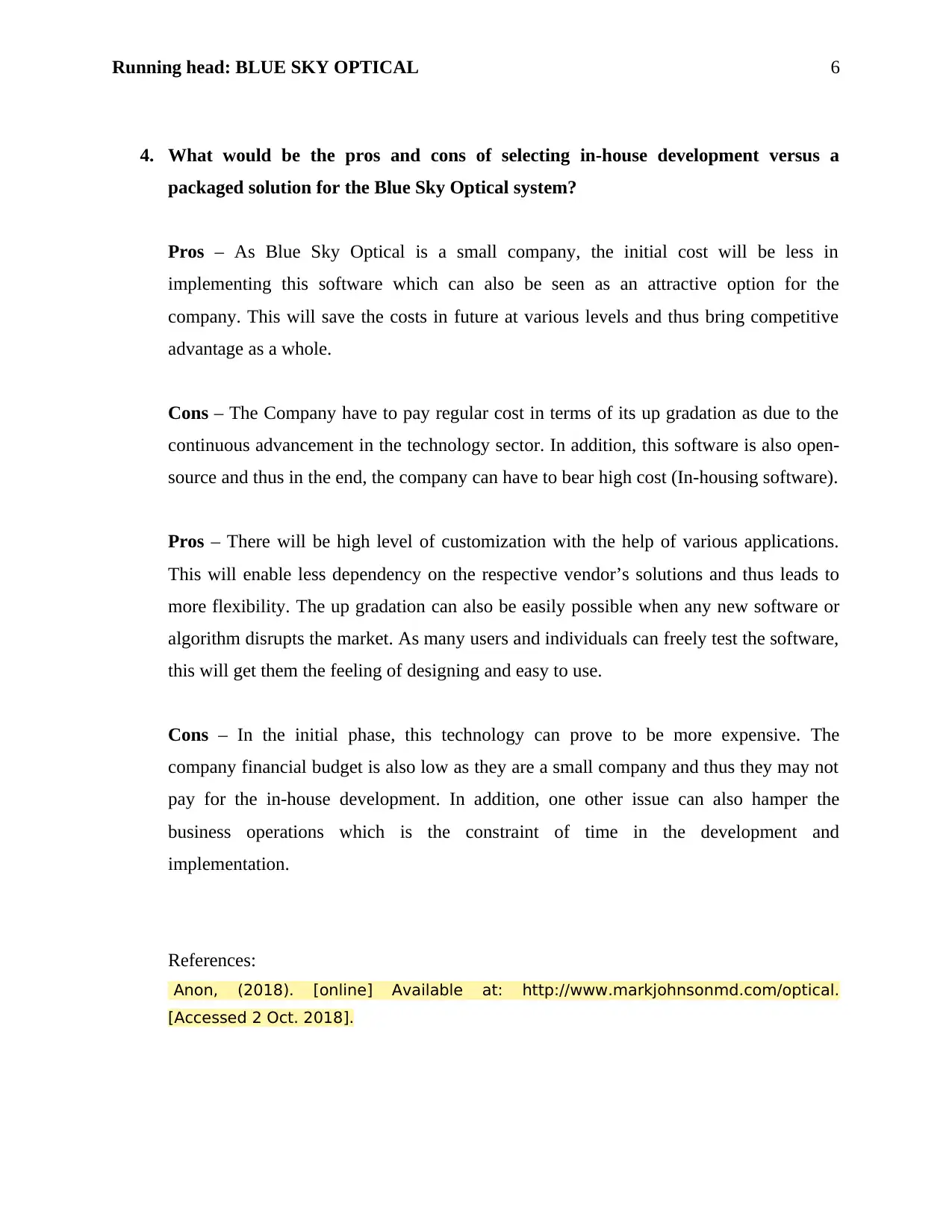
Running head: BLUE SKY OPTICAL 6
4. What would be the pros and cons of selecting in-house development versus a
packaged solution for the Blue Sky Optical system?
Pros – As Blue Sky Optical is a small company, the initial cost will be less in
implementing this software which can also be seen as an attractive option for the
company. This will save the costs in future at various levels and thus bring competitive
advantage as a whole.
Cons – The Company have to pay regular cost in terms of its up gradation as due to the
continuous advancement in the technology sector. In addition, this software is also open-
source and thus in the end, the company can have to bear high cost (In-housing software).
Pros – There will be high level of customization with the help of various applications.
This will enable less dependency on the respective vendor’s solutions and thus leads to
more flexibility. The up gradation can also be easily possible when any new software or
algorithm disrupts the market. As many users and individuals can freely test the software,
this will get them the feeling of designing and easy to use.
Cons – In the initial phase, this technology can prove to be more expensive. The
company financial budget is also low as they are a small company and thus they may not
pay for the in-house development. In addition, one other issue can also hamper the
business operations which is the constraint of time in the development and
implementation.
References:
Anon, (2018). [online] Available at: http://www.markjohnsonmd.com/optical.
[Accessed 2 Oct. 2018].
4. What would be the pros and cons of selecting in-house development versus a
packaged solution for the Blue Sky Optical system?
Pros – As Blue Sky Optical is a small company, the initial cost will be less in
implementing this software which can also be seen as an attractive option for the
company. This will save the costs in future at various levels and thus bring competitive
advantage as a whole.
Cons – The Company have to pay regular cost in terms of its up gradation as due to the
continuous advancement in the technology sector. In addition, this software is also open-
source and thus in the end, the company can have to bear high cost (In-housing software).
Pros – There will be high level of customization with the help of various applications.
This will enable less dependency on the respective vendor’s solutions and thus leads to
more flexibility. The up gradation can also be easily possible when any new software or
algorithm disrupts the market. As many users and individuals can freely test the software,
this will get them the feeling of designing and easy to use.
Cons – In the initial phase, this technology can prove to be more expensive. The
company financial budget is also low as they are a small company and thus they may not
pay for the in-house development. In addition, one other issue can also hamper the
business operations which is the constraint of time in the development and
implementation.
References:
Anon, (2018). [online] Available at: http://www.markjohnsonmd.com/optical.
[Accessed 2 Oct. 2018].

Running head: BLUE SKY OPTICAL 7
1 out of 7
Related Documents
Your All-in-One AI-Powered Toolkit for Academic Success.
+13062052269
info@desklib.com
Available 24*7 on WhatsApp / Email
![[object Object]](/_next/static/media/star-bottom.7253800d.svg)
Unlock your academic potential
© 2024 | Zucol Services PVT LTD | All rights reserved.





